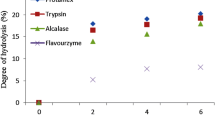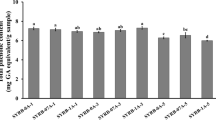Abstract
Rice bran is a by-product obtained from the rice grain milling process that has amounts of nutrients. The objective of this study was to characterize the physicochemical and antioxidant properties of rice bran protein hydrolyzes (RBPHs) by Bacillus licheniformis (RBPH-BL), Aspergillus oryzae (RBPH–AO), and α-chymotrypsin (RBPH–C). The amino acid profile, secondary protein structure, molecular weight, and antioxidant activities of RBPHs were investigated. It was observed that RBPH–C (44%) exhibited a higher degree of hydrolysis (DH) than the other RBPHs, whereas RBPH–BL (134.65 mg/kg) provided the highest content of total essential amino acids. The amino acid composition of the RBPHs compared favorably with the reference standard recommended by WHO/FAO/UNU. The RBPHs were composed of mainly β-sheet secondary structures with a low molecular weight. The RBPHs exhibited high DPPH scavenging ability and reducing power, whereas the RBPH-BL exhibited lipid peroxidation inhibition with an increase in DH. Therefore, RBPH, with its abundant amino acids and high antioxidant activity, can be a potential plant protein source in the food industry.





Similar content being viewed by others
Data availability
The data that support the findings of this study are available on request from the corresponding author. The data are not publicly available due to their containing information that could compromise the privacy of research participants.
Code availability
Code for data cleaning and analysis is provided as part of the replication package. We use a Statistical Package for the Social Sciences (SPSS) program Version 22 from the property of IBM Corporation and other(s) 1989, 2013, it was installed with correctly License code (9DNCAF2O3QVDV7FBIO696OO6GWLNXZPPRYTPWF2PPX7C8T6Y24LMVV2ET7DOLX5CXAL5YDLL79UPGEFCPDXP5Q8O5E).
References
USDA, “Rice outlook,“ United States Department of Agriculture, (2021)
C. Sowcharoensuk, “Industry Outlook 2022–2024: Rice Industry,“ Krungsri Research, (2022)
U. Najamuddin, S.G. Gorji, M. Fitzgerald, Genotypic variability in the composition of soluble protein from rice bran – Opportunities for nutrition. J. Food Compos. Anal. 103, 104077 (2021). https://doi.org/10.1016/j.jfca.2021.104077
M. Alauddin, Rice Bran as a functional food: an overview of the Conversion of Rice Bran into a Superfood/Functional. (2017)
C. Kalpanadevi, S.P. Muthukumar, K. Govindaraju, R. Subramanian, Rice bran protein: an alternative plant-based protein to ameliorate protein malnourishment. J. Cereal Sci. 97, 103154 (2021). https://doi.org/10.1016/j.jcs.2020.103154
S.-W. Han, K.-M. Chee, S.-J. Cho, Nutritional quality of rice bran protein in comparison to animal and vegetable protein. Food Chem. 172, 766–769 (2015). https://doi.org/10.1016/j.foodchem.2014.09.127
T.P. Singh, R.A. Siddiqi, D.S. Sogi, Enzymatic modification of rice bran protein: impact on structural, antioxidant and functional properties. LWT (2021). https://doi.org/10.1016/j.lwt.2020.110648
T. Pantoa, M. Kubota, P. Suwannaporn, M. Kadowaki, Characterization and bioactivities of young rice protein hydrolysates. J. Cereal. Sci. 95, 103049 (2020). https://doi.org/10.1016/j.jcs.2020.103049
S.R. Shahosseini, S.R. Javadian, R. Safari, Effects of molecular weights -assisted enzymatic hydrolysis on antioxidant and anticancer activities of liza abu muscle protein hydrolysates. Int. J. Pept. Res. Ther. 28(2), 72 (2022). https://doi.org/10.1007/s10989-022-10371-8
S. Phongthai, S.-T. Lim, S. Rawdkuen, Optimization of microwave-assisted extraction of rice bran protein and its hydrolysates properties. J. Cereal Sci. 70, 146–154 (2016). https://doi.org/10.1016/j.jcs.2016.06.001
T.P. Singh, R.A. Siddiqi, D.S. Sogi, “Statistical optimization of enzymatic hydrolysis of rice bran protein concentrate for enhanced hydrolysate production by papain. LWT 99, 77–83 (2019). https://doi.org/10.1016/j.lwt.2018.09.014
S. Phongthai, S. D’Amico, R. Schoenlechner, W. Homthawornchoo, S. Rawdkuen, “Fractionation and antioxidant properties of rice bran protein hydrolysates stimulated by in vitro gastrointestinal digestion.” Food Chem. 240, 156–164 (2018). https://doi.org/10.1016/j.foodchem.2017.07.080
S.N. Jamdar, V. Rajalakshmi, M.D. Pednekar, F. Juan, V. Yardi, A. Sharma, Influence of degree of hydrolysis on functional properties, antioxidant activity and ACE inhibitory activity of peanut protein hydrolysate. Food Chem 121(1), 178–184 (2010). https://doi.org/10.1016/j.foodchem.2009.12.027
L. Amagliani, J. O’Regan, C. Schmitt, A.L. Kelly, J.A. O’Mahony, Characterisation of the physicochemical properties of intact and hydrolysed rice protein ingredients. J. Cereal Sci. 88, 16–23 (2019). https://doi.org/10.1016/j.jcs.2019.04.002
P. Fathi, M. Moosavi-Nasab, A. Mirzapour-Kouhdasht, M. Khalesi, Generation of hydrolysates from rice bran proteins using a combined ultrasonication-alcalase hydrolysis treatment. Food Biosci. 42, 101110 (2021). https://doi.org/10.1016/j.fbio.2021.101110
L. Lin, X. Yu, Y. Gao, L. Mei, Z. Zhu, X. Du, Physicochemical properties and in vitro starch digestibility of wheat starch/rice protein hydrolysate complexes. Food Hydrocoll. 125(2022)
J. Xiao et al., “Enzymatic preparation and antioxidative activity of hydrolysate from Rice bran protein.” J. Food Meas. Charact. 14(6), 3163–3174 (2020). https://doi.org/10.1007/s11694-020-00563-5
M. Hayta, B. Benli, E.M. İşçimen, A. Kaya, Optimization of antihypertensive and antioxidant hydrolysate extraction from rice bran proteins using ultrasound assisted enzymatic hydrolysis. J. Food Meas. Charact. 14(5), 2578–2589 (2020). https://doi.org/10.1007/s11694-020-00504-2
R. Noptana, E. Onsaard, “Enhanced physical stability of rice bran oil-in-water emulsion by heat and alkaline treated proteins from rice bran and soybean.” Sci. Technol. Asia 23(1), 9–16 (2018)
M. Qi, N.S. Hettiarachchy, U. Kalapathy, Solubility and emulsifying properties of soy protein isolates modified by pancreatin. J. Food Sci. (1997). https://doi.org/10.1111/j.1365-2621.1997.tb12224.x
Y. Li, J. Zhou, K. Huang, Y. Sun, X. Zeng, Purification of a novel angiotensin I-converting enzyme (ACE) inhibitory peptide with an antihypertensive effect from loach (Misgurnus anguillicaudatus). J. Agric. Food Chem. 60(5), 1320–1325 (2012). https://doi.org/10.1021/jf204118n
U.K. Laemmli, “Cleavage of structural proteins during the assembly of the head of bacteriophage T4, “ (in eng). Nature 227(5259), 680–5 (1970). https://doi.org/10.1038/227680a0
K. Shimada, K. Fujikawa, K. Yahara, T. Nakamura, Antioxidative properties of xanthan on the autoxidation of soybean oil in cyclodextrin emulsion. J. Agric. Food Chem. 40(6), 945–948 (1992). https://doi.org/10.1021/jf00018a005
R.J.S. de Castro, H.H. Sato, “Synergistic actions of proteolytic enzymes for production of soy protein hydrolysates with antioxidant activities: an approach based on enzymes specificities.” Biocatal. Agric. Biotechnol. 4(4), 694–702 (2015). https://doi.org/10.1016/j.bcab.2015.08.012
D. Doucet, S.F. Gauthier, D.E. Otter, E.A. Foegeding, “Enzyme-Induced Gelation of extensively hydrolyzed whey proteins by Alcalase: comparison with the plastein reaction and characterization of Interactions.” J. Agric. Food Chem. 51(20), 6036–6042 (2003). https://doi.org/10.1021/jf026041r
Y. xu, et al., Effect of enzymatic hydrolysis using endo- and exo-proteases on secondary structure, functional, and antioxidant properties of chickpea protein hydrolysates. J. Food Meas. Charact. (2020). https://doi.org/10.1007/s11694-019-00296-0
I.B.B. Piotrowicz, M. Garcés-Rimón, S. Moreno-Fernández, A. Aleixandre, M. Salas-Mellado, M. Miguel-Castro, “Antioxidant, Angiotensin-Converting Enzyme Inhibitory Properties and Blood-Pressure-Lowering Effect of Rice Bran Protein Hydrolysates,“ Foods, vol. 9, no. 6, p. 812 (2020). [Online]. Available: https://doi.org/https://www.mdpi.com/2304-8158/9/6/812
I.A. Jayawardana et al., “The kiwifruit enzyme actinidin enhances the hydrolysis of gluten proteins during simulated gastrointestinal digestion.” Food Chem. 341, 128239 (2021). https://doi.org/10.1016/j.foodchem.2020.128239
P.R. Shewry, N.G. Halford, “Cereal seed storage proteins: structures, properties and role in grain utilization, “ (in eng). J. Exp. Bot. 53(370), 947–58 (2002). https://doi.org/10.1093/jexbot/53.370.947
S.P. Samaei et al., “Functional, nutritional, antioxidant, sensory properties and comparative peptidomic profile of faba bean (Vicia faba, L.) seed protein hydrolysates and fortified apple juice.” Food Chem 330, 127120 (2020). https://doi.org/10.1016/j.foodchem.2020.127120
T.L. Pownall, C.C. Udenigwe, R.E. Aluko, Amino acid composition and antioxidant properties of pea seed (Pisum sativum L.) enzymatic protein hydrolysate fractions,“ (in eng). J. Agric. Food Chem. 58(8), 4712–4718 (2010). https://doi.org/10.1021/jf904456r
A.R. Adesanmi, S.A. Malomo, T.N. Fagbemi, “Nutritional quality of formulated complementary diet from defatted almond seed, yellow maize and quality protein maize flours, “ Food Production. Process. Nutr. 2(1), 23 (2020). https://doi.org/10.1186/s43014-020-00037-7
T. Longvah, K. Mangthya, K. Subhash, S. Sen, S. Rathi, Comprehensive nutritional evaluation of popular rice varieties of Assam, Northeast India. J. Food Compos. Anal. 101, 103952 (2021). https://doi.org/10.1016/j.jfca.2021.103952
L. Zhou, Y. Zhang, C. Zhao, H. Lin, Z. Wang, F. Wu, Structural and functional properties of rice bran protein oxidized by peroxyl radicals. Int. J. Food Prop. 20(sup2), 1456–1467 (2017). https://doi.org/10.1080/10942912.2017.1352596
L. Amagliani, J. O’Regan, A.L. Kelly, J.A. O’Mahony, Composition and protein profile analysis of rice protein ingredients. J. Food Compos. Anal. 59, 18–26 (2017). https://doi.org/10.1016/j.jfca.2016.12.026
A. Adebiyi, A. Adebiyi, Y. Hasegawa, T. Ogawa, K. Muramoto, Isolation and characterization of protein fractions from deoiled rice bran. Eur. Food Res. Technol. 228, 391–401 (2009). https://doi.org/10.1007/s00217-008-0945-4
L. Wattanasiritham, C. Theerakulkait, S. Wickramasekara, C.S. Maier, J.F. Stevens, “Isolation and identification of antioxidant peptides from enzymatically hydrolyzed rice bran protein, “ (in eng). Food Chem. 192, 156–62 (2016). https://doi.org/10.1016/j.foodchem.2015.06.057
W. Chanput, C. Theerakulkait, S. Nakai, Antioxidative properties of partially purified barley hordein, rice bran protein fractions and their hydrolysates. J. Cereal Sci. 49, 422–428 (2009). https://doi.org/10.1016/j.jcs.2009.02.001
Acknowledgements
This study is a part of research project funded by National Research Council of Thailand (NRCT). The authors would like to thank Indigenous Food Research and Industrial Development Center, Faculty of Agriculture, Ubon Ratchathani University for supporting facilities and equipment.
Funding
All of the sources of funding for the work described in this publication are acknowledged bellows: National Research Council of Thailand (NRCT), Indigenous Food Research and Industrial Development Center, Faculty of Agriculture, Ubon Ratchathani University.
Author information
Authors and Affiliations
Contributions
WO and EO performed the experimental works, and WO was a major contributor to the manuscript, with assistance from EO and SK-N. EO supervised the project. All authors read and approved the manuscript.
Corresponding author
Ethics declarations
Conflict of interest
We wish to confirm that there are no known conflicts of interest associated with this publication and there has been no significant financial support for this work that could have influenced its outcome.
Ethical approval
This article does not contain any studies with human or animal subjects performed by any of the authors.
Additional information
Publisher’s Note
Springer Nature remains neutral with regard to jurisdictional claims in published maps and institutional affiliations.
Rights and permissions
Springer Nature or its licensor (e.g. a society or other partner) holds exclusive rights to this article under a publishing agreement with the author(s) or other rightsholder(s); author self-archiving of the accepted manuscript version of this article is solely governed by the terms of such publishing agreement and applicable law.
About this article
Cite this article
Onsaard, W., Kate-Ngam, S. & Onsaard, E. Physicochemical and antioxidant properties of rice bran protein hydrolysates obtained from different proteases. Food Measure 17, 2374–2385 (2023). https://doi.org/10.1007/s11694-022-01796-2
Received:
Accepted:
Published:
Issue Date:
DOI: https://doi.org/10.1007/s11694-022-01796-2




